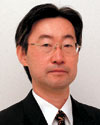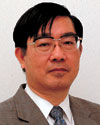 |
Yutaka KAWAGUCHI,
Senior Research Engineer,
Digital Satellite
Broadcasting Systems |
Digital BS broadcasting allows a viewer to receive information provided
via data broadcasting services, while simultaneously enjoying a clear
Hi-Vision (HDTV) service. It is expected that in the future such multimedia
broadcasts will be combined with the Internet, thus becoming a virtually
indispensable information source for daily living. Digital BS broadcasting
currently employs a 12-GHz-band radio wave. Future satellite broadcasting
systems featuring more diverse services will probably use higher frequencies,
such as the 21-GHz band, and this has become an important focus of our
research.
Broadcasting on such high frequencies has the problem of significant radio
wave degradation, due to rain attenuation. Therefore, we are working on
a variety of radio attenuation compensation schemes, including a phased
array antenna technology, to heighten transmission gain in areas with
rainfall. We have also been making observations and analyses of rain attenuation
amounts, to compute the amount of compensation required. Additionally,
large-capacity hard disk systems capable of recording many programs have
become a reality. In line with this development, another ongoing research
project involves a long block-length interleaving transmission scheme
with the ability to compensate for rain attenuation by transmitting data
dispersed over a long period. |


